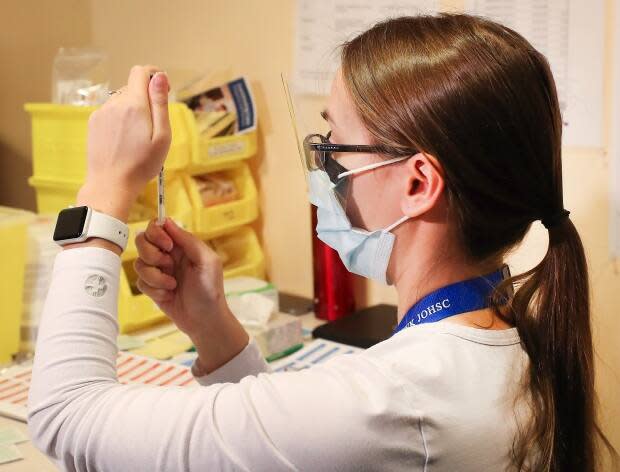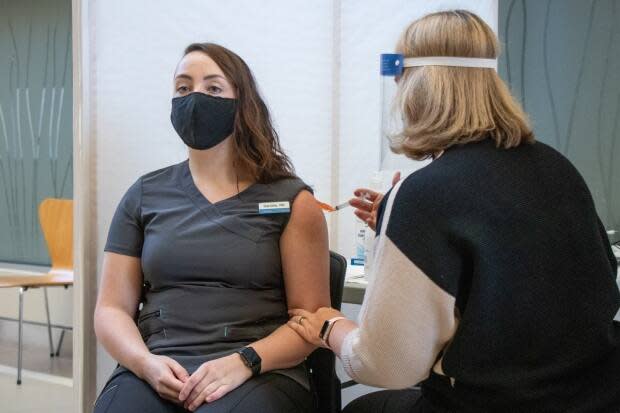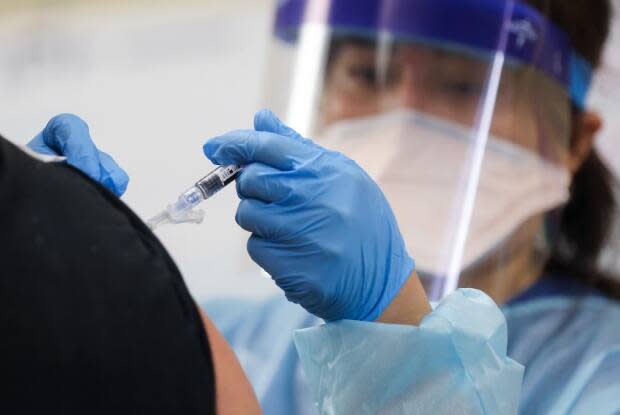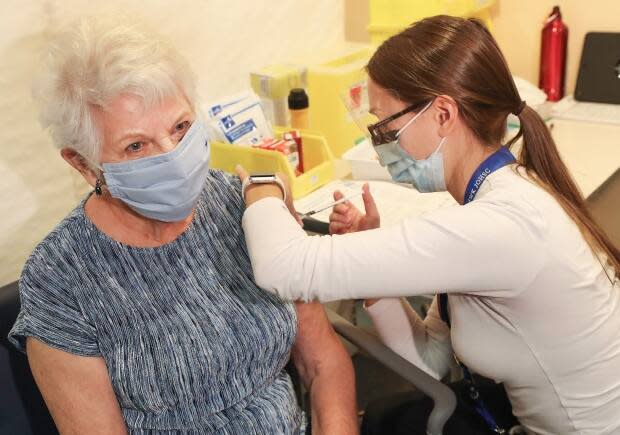Nova Scotia's vaccination strategy picks up speed following early criticism

Nova Scotia's COVID-19 vaccine rollout is gaining steam, after initially facing criticism for immunizing its population at a slower rate than other provinces.
The proportion of the province's population that has received at least one dose has more than doubled in less than two weeks. On April 8, it sat at 10.2 per cent. On Tuesday, Premier Iain Rankin announced it had reached 21.9 per cent.
It still remains slightly below the national average. Roughly a quarter of Canadians have received at least one dose of vaccine.
"The percentage is a legacy of that decision to hold back that second dose," Nova Scotia Chief Medical Officer of Health Dr. Strang said last week. "That put us behind some other provinces, but that was very much the right decision at the time.
"The narrative that we're slow is actually an old narrative. We're developing a robust, reliable, flexible, quality program that can meet the supply as we get it in a very timely manner, and we're in a faster-growing trajectory than many other provinces."

Halifax epidemiologist Kevin Wilson said Monday that Nova Scotia has "pretty drastically ramped up its speed of vaccination" over the last two weeks.
Wilson said in the preceding week he'd seen the average number of people vaccinated per day rise from about 0.2-0.4 per cent of the population, to 0.8 per cent.
Wilson said during mid-March he saw a lot of provinces start to accelerate their vaccine rollout. Nova Scotia was the last province, by about a week, to accelerate.
"Everyone started leaving first, everyone started accelerating and then Nova Scotia, a little bit after that, started going," he said. "But if you start a week late and everyone's going very quickly, then it ends up in a place where even though you're only a week behind you look like you're very far behind."
Wilson said another way to describe it is that Nova Scotia's rollout is where the rest of the country was about a week to a week and a half earlier, and it is closing the gap.

"In the grand scheme of things, I'd prefer not to be behind. But if you're going to be behind, that's really not a lot in the grand scheme of a half-year-long vaccination rollout," he said.
Wilson said it is difficult to make predictions about exactly when Nova Scotia might close the gap and draw level with the Canadian average for the percentage of people who have received at least one dose.
The held back doses
Strang and Tracey Barbrick, the associate deputy minister responsible for the COVID-19 immunization strategy, have explained the delay in Nova Scotia's acceleration as a side effect of the decision to hold back doses for second shots.
Starting in late December, provinces like Quebec and Manitoba announced they would extend the time between doses of Pfizer-BioNTech and Moderna vaccines beyond the makers' recommendations. British Columbia, Alberta, Saskatchewan and Ontario joined them.
Through February and early March all the other Atlantic provinces announced they would move to a longer dosing interval.
Nova Scotia was the last holdout, changing its strategy only in the week of March 15-22. Strang announced the change publicly on March 23.
At that point the province had received 119,110 doses in total, but said 21,856 of them were being stored to give second doses to every person who had been promised a second dose prior to the policy change.
Barbrick later told CBC that number of held back doses ended up being 25,000.
"That 25,000 doses for the second arm, if you will, actually was a fairly significant portion of a small supply of vaccine," Barbrick told CBC's Mainstreet. "It shows up there. It's kind of plagued us a little bit."

In addition to those who received a first dose prior to the policy change, Barbrick said the province also made some "equity decisions" to "tuck away" some shots to ensure second doses can be offered to certain groups on the manufacturer's schedule.
Those include long-term care residents and staff, homeless shelter clients and staff, participants in day programs, residential care facilities, small options homes, First Nations and African Nova Scotian elders.
The province confirmed last Friday it has finished offering all of the second doses to people who were promised them prior to mid-March, but it continues to hold back some supply for those populations covered by the equity decisions. The Department of Health and Wellness was unable to say exactly how many shots fell in that category.
'Get good, then fast'
Strang has repeatedly said at briefings that the province's goal is first to "get good, then get fast," and that the speed of immunization is dependent on vaccine supply from the federal government.
On Tuesday, Rankin warned of instability in the next two weeks of supply due to problems with Moderna shipments.
However, as supplies have arrived the number of operating vaccination sites is growing in the pharmacies and primary care clinics that will deliver the majority of shots.

There were 46 pharmacy sites giving shots in the week of April 8, rising to 114 pharmacies by the week of April 13. The Pharmacy Association of Nova Scotia has said there are 312 pharmacies in the province and it anticipates about 300 of them will eventually offer vaccinations.
Wilson said as a Nova Scotian he's "much happier" to see the recent acceleration in the vaccine rollout. Although some provinces are out in front, he said, the overall range between provinces is relatively small, and he likens it to a road trip to a faraway destination.
"So we're on a road trip together," he said. "Some of us are a little bit further ahead, a little bit closer to the destination than others. Nova Scotia is five minutes behind. It's really not that big of a gap with the rest of the provinces. And currently it looks like they're speeding up to accommodate that gap."
MORE TOP STORIES

 Yahoo Movies
Yahoo Movies 